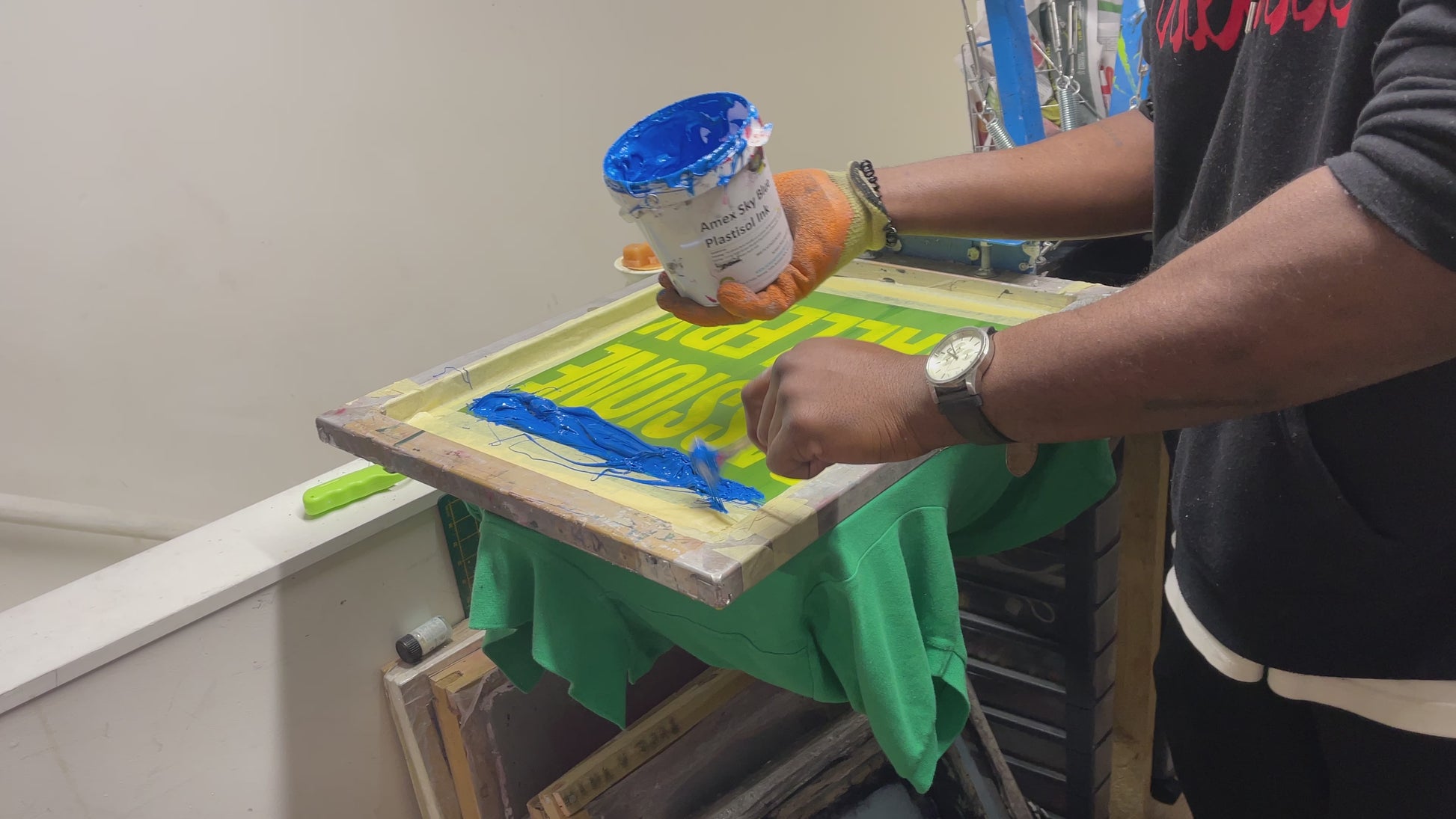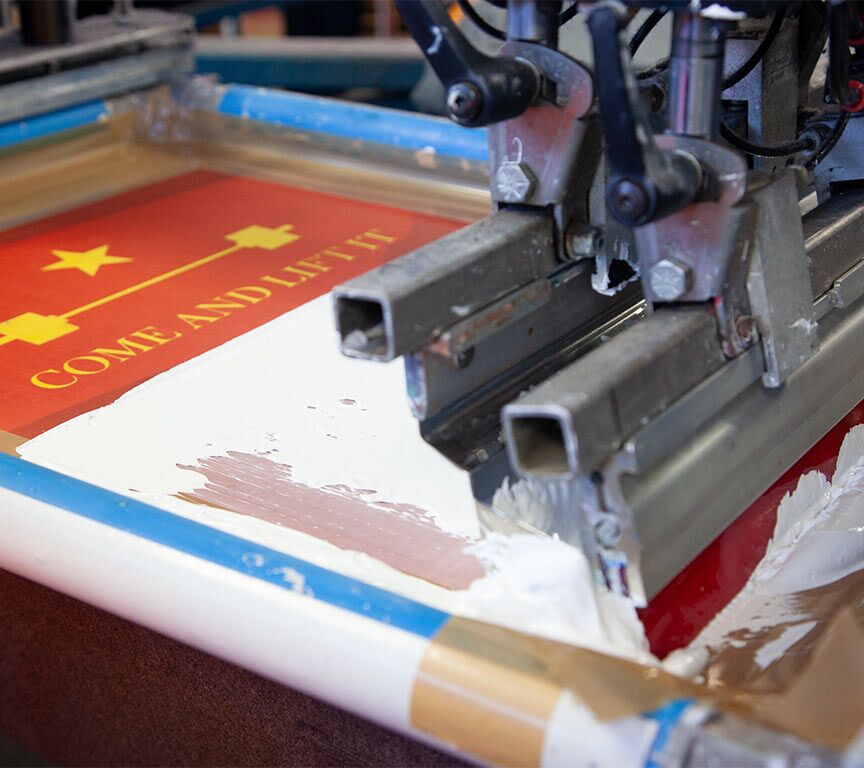Screen Printing Uncovered: Whatever You Need to Know Regarding T-Shirt and Garment Printing Strategies
If you've ever before questioned exactly how those vibrant designs wind up on your favored tees, you're in the right place. Screen printing is an interesting approach that integrates art with technique, using unlimited possibilities for creative thinking. Comprehending the principles, from equipment to ink selections, can substantially affect your outcomes. All set to check out the vital aspects that make screen printing an art form? Allow's uncover the details that can elevate your projects.
The Fundamentals of Display Printing: Exactly How It Functions
When you dive right into screen printing, you'll discover it's both an art and a scientific research. At its core, display printing entails producing a pattern, or screen, that enables ink to travel through just in details locations (screen printing kit). You begin by picking your style and preparing your screen with a light-sensitive solution. When you reveal this emulsion to light, it hardens, leaving your layout as an adverse space.
Next, you'll blend your inks and prepare your printing surface area. Placement the display over the textile, then use a squeegee to press ink with the display onto the garment. This procedure requires precision, as you desire clear, vivid prints. After printing, you'll treat the ink with warmth, guaranteeing it complies with the material and lasts through washes. Each action is necessary, and grasping them will elevate your screen printing skills, transforming basic garments right into unique, expressive items.
Kinds of Screen Printing Techniques
As soon as you grasp the essentials of screen printing, it's time to explore the various techniques that can elevate your layouts. One preferred approach is traditional display printing, where ink is pressed via a stenciled display.
If you're going for fine information, think about discharge printing. This technique eliminates color from the material, leaving a soft, classic appearance. Another option is plastisol printing, understood for its longevity and vibrant shades, making it a favorite for many brand names. Lastly, try out halftone printing to produce slope impacts and elaborate designs. Each strategy has its unique appeal, so do not hesitate to attempt them bent on find what suits your design best!
Crucial Equipment for Screen Printing
To accomplish magnificent results in display printing, having the appropriate tools is fundamental. You'll require a tough screen printing structure, which holds the mesh that moves your design onto the garment. Next, spend in high-grade mops; these are essential for using ink uniformly throughout the display.
Selecting the Right Inks and Products
When selecting inks and materials for screen printing, you need to take right into account the type of ink that functions best for your job. Think of material compatibility to ensure your designs look last and wonderful long. Check out green ink options to make your printing procedure more lasting.
Kinds Of Display Inks
Choosing the appropriate display ink is crucial for accomplishing dynamic, sturdy prints that satisfy your task's demands. There are several kinds of display inks to check out. Specialty inks, such as metal or glow-in-the-dark, can add unique results to your styles.

Material Compatibility Factors To Consider
Recognizing fabric compatibility is crucial for achieving premium screen prints, especially considering that different products react distinctively to numerous inks. Always examine your inks on example material to assure they stick correctly and preserve color integrity. Additionally, maintain in mind that fabric weight and structure can influence the final result, so choosing the right ink and product combination is vital for your job's success.
Eco-Friendly Ink Options
Eco-friendly inks are coming to be a preferred selection for display printers that want to lessen their environmental impact while keeping top quality. When choosing inks, consider water-based inks, which are less dangerous and much easier to cleanse up contrasted to typical solvents.
In addition, search for inks made from renewable energies, such as soy or vegetable-based options. By choosing the right inks and materials, you'll not only develop sensational designs however additionally contribute to a more sustainable printing process. Make the button, and your prints will show your dedication to the setting!
Preparing Your Design for Screen Printing

Submit Style Needs
To assure your design looks lively and sharp on textile, you'll require to pay close focus to file style demands for display printing. Make sure your design has a transparent background to protect against unwanted white edges on your prints. Keep color modes in mind; CMYK is standard for screen printing, so convert your RGB makes accordingly.
Shade Splitting Up Strategies
Shade separation is an essential step in preparing your layout for screen printing, and understanding it can substantially boost your print top quality. You'll require to break your layout into specific colors, as each color needs a separate screen throughout printing. This precision not just ensures exact shade representation yet also simplifies the printing procedure.
Resolution and Dimension
Attaining the very best cause screen printing starts with ensuring your layout has the best resolution and size. Ideally, your art work must go to least 300 DPI (dots per inch) for sharp, clear prints. If you use reduced resolution, your end product might look pixelated and unprofessional.
When it pertains to dimension, think about the dimensions of your print area. Design your art work to match the last print dimension, preferably creating it in the actual measurements you'll be printing. By doing this, you'll stay clear of any kind of unanticipated scaling concerns.
Constantly inspect your design in both vector and raster layouts. Vector graphics can be scaled without losing quality, making them excellent for screen printing. Preparing properly will assure your design looks remarkable on every garment!
Step-by-Step Display Printing Process
Screen printing is a dynamic process that enables you to develop dynamic designs on numerous surface areas. To get started, you'll require a screen, emulsion, and your selected ink.
Put ink onto the screen and use a squeegee to press the Learn More Here ink with the stencil onto the fabric. Lift the display very carefully and let the print completely dry. You've successfully screen printed your layout.
Tips for Successful Display Printing Projects
While you're diving into your screen printing tasks, bear in mind that prep work is vital to success. Begin by gathering all your products-- inks, garments, squeegees, and displays. A tidy work space helps avoid unwanted errors, so clean before you begin.
Following, confirm your art work is high-resolution and correctly sized for your garment. Examine your screen for appropriate exposure and clean it completely to avoid spots. When mixing your inks, comply with the supplier's guidelines to attain the right consistency.
Throughout printing, apply even pressure with your squeegee for constant outcomes. Don't hurry; take your time to verify each print fulfills your criteria. After printing, let your garments completely dry completely prior to managing or packaging them.
Finally, always keep an example of your benefit future recommendation. By doing this, you can analyze your progression and enhance your techniques over time. Happy printing!

Frequently Asked Questions
The length of time Does It Take to Set up a Display Printing Work?
Establishing a screen printing work normally takes about half an hour to an hour. You'll prepare the screens, mix inks, and change the press. The time varies based on complexity and experience, so remain arranged!
Can I Print on Different Textile Keys In Making Use Of the Very Same Method?
Yes, you can publish on different fabric kinds utilizing the same method, but you'll need to adjust your inks and settings. Some textiles soak up ink in different ways, so trying out guarantees the finest outcomes for each material.
What Prevail Blunders to Avoid in Display Printing?
When display printing, prevent typical blunders like using the wrong ink, neglecting proper exposure times, or avoiding pre-press additional hints checks. Always test your arrangement and preserve tidy displays to assure top quality results each time.
How Can I Effectively Clean and Preserve My Display Printing Devices?
To effectively clean and keep your display printing devices, you must frequently wash screens with proper solvents, check squeegees for wear, and guarantee all devices are stored dry and dust-free. Consistency protects against pricey repair services and improves efficiency.
Is Display Printing Eco-friendly Contrasted to Other Approaches?
Screen printing can be extra ecologically pleasant than various other approaches, especially if you make use of water-based inks and eco-conscious products. By picking lasting supplies and techniques, you decrease waste and reduce your influence on the earth.
Screen Printing Uncovered: Everything You Required to Know About Tee Shirt and Garment Printing Techniques
At its core, display printing includes creating a pattern, or display, that allows ink to pass through only in details areas. Setting the display over the fabric, after that utilize a squeegee to press ink through the screen onto the garment. One preferred method is traditional screen printing, where ink is pushed through a stenciled display.When choosing inks and materials for display printing, you need to take right into account the type of ink that functions finest for your job.